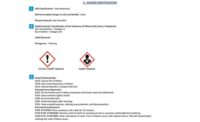According to studies done by OSHA, the language used in MSDSs is typically beyond the technical literacy level of the average worker. Teaching them to understand technical terms in MSDSs is difficult because many of these terms are abstract and unfamiliar. Analogies are a powerful tool in helping bridge this gap between the known and unknown and can help them understand and retain otherwise complex and unfamiliar terms.
Bridging the gap
By definition, an analogy is a non-literal comparison between two things. Analogies use the adult learner's wide experience base to build relationships between known, familiar concepts and unknown, complex concepts. This comparison helps learners comprehend, visualize and remember new concepts. As well-known educator David Jonassen says, "Analogies are the single most powerful instructional strategy one can use."Results from a research project to teach MSDS terms also support the value of using analogies as a learning tool. The Apprentice Training Curriculum at the U.S. Naval Recruit Command in Great Lakes, IL, involved a one-hour module on MSDSs in the safety portion of the curriculum. The project's 800+ participants were randomly divided into 3 groups to learn MSDS terms and definitions and tested at the end.
Each group had a different teaching strategy to learn the MSDS terms. While the control group participants were just given the basic definitions of the terms, the other two groups either generated their own analogies or were supplied with analogies. In the final analysis, participants who used analogies or were familiar with analogies and used them as a study tool for the test, were able to recall definitions of hazardous chemical terms and apply definitions more easily.
10 common MSDS terms: definition and analogies
1. Absorption is the movement of a chemical into a plant, animal or soil. This is an exposure route into your body. Absorption can be compared to a sponge used to soak up spilled water.2. Acute is the short-term effect which occurs when exposed to a chemical for a short time. An example of an acute effect would be a blast of steam on bare skin that causes burns.
3. Adsorption means to collect gas or liquid modules onto the surface of another material. Rain that beads on the hood of a newly waxed car would be an analogy for adsorption.
4. Chronic is a long-term effect resulting from long-term exposure. An example of a chronic condition would be sore feet from wearing tight shoes for a long time.
5. Exposure Routes are one of four ways that hazards enter the body. The four most common routes of entry are absorption (through the skin), ingestion (swallowing), inhalation (breathing) and injection (punctures). Exposure routes can be compared to highways into your body, a distinct path that something can travel to reach a destination.
6. Flammable Limits can be described as Lower and Upper Limits. Flammables have a minimum concentration below which spreading of flame does not occur if a source of ignition is present. The upper limit is the maximum concentration of vapor or gas in air above which spreading of flame does not occur if a source of ignition is present. The flammable limits can be compared to the proper adjustment of a carburetor on a car.
7. Permissible Exposure Limits are the maximum safe breathable exposure limits established by OSHA for chemicals in the air. This may be expressed as a time-weighted average concentration (TWA) or a ceiling exposure limit that legally must never be exceeded. The permissible exposure limit is like the speed limit enforced by the police at a speed trap.
8. Specific Gravity is the measurement of a weight of the volume of liquid or solid, compared to the weight of an equal volume of water. Water has a specific gravity of 1.0. Materials with a specific gravity under 1.0 will float in the water, while material with a specific gravity over 1.0 will sink. An example of a material with a specific gravity over 1.0 is a rock and it will sink in the water. A cork, however, will float since its specific gravity is less than 1.0.
9. Threshold Limit Value -- C is the ceiling or maximum safe breathable concentration that should not be exceeded. The lower the number, the higher the hazard. The Threshold Limit Value C can be compared to a car with a governor; you can't go faster than the setting of the governor.
10. Threshold Limit Value -- TWA is the time-weighted average maximum safe breathable concentration of a chemical to which nearly all workers may be exposed for a normal 8-hour workday and a 40-hour work week without being harmed. The lower the number, the higher the hazard. You can compare the Threshold Limit Value - TWA to the posted speed limit for safe driving.



